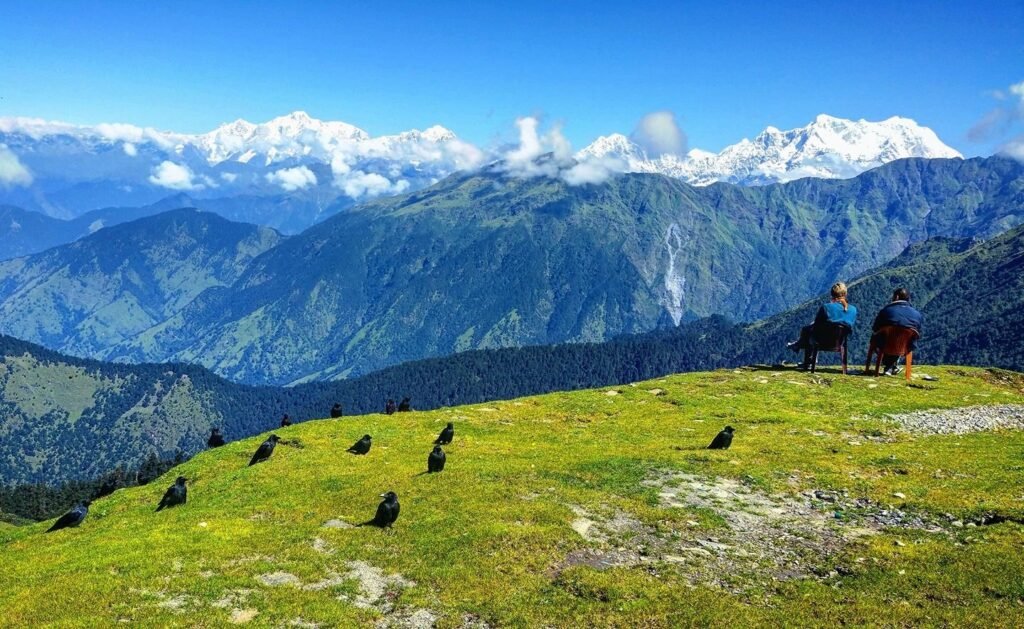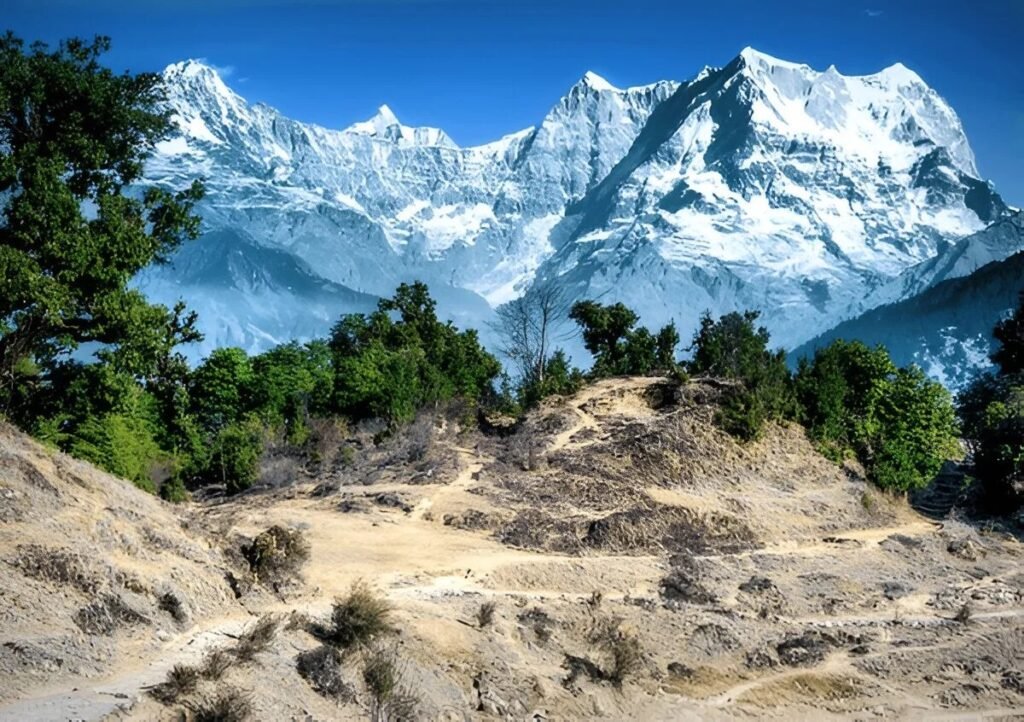Chaukhamba Mountain is one of the most iconic mountains in the Garhwal Himalayas of Uttarakhand, India. Famous for its towering four summits or “pillars,” this massif stands proudly at the head of the Gangotri Glacier. Chaukhamba I, the highest of the four peaks, ascends to an elevation of 7,138 meters (23,419 feet), making it a major landmark for climbers and pilgrims alike. Located just west of the sacred town of Badrinath, this mountain blends serene natural beauty with spiritual significance, offering explorers a unique blend of adventure and culture.
Location and Physical Characteristics
Chaukhamba Mountain is situated as part of the Gangotri Group in the Garhwal Himalaya, northern Uttarakhand. The massif features four prominent summits arranged from northeast to southwest along a ridge, collectively referred to as Chaukhamba I, II, III, and IV, with elevations ranging from 7,138 meters to 6,854 meters. Its striking four-pillared shape is the reason behind its name, derived from Hindi (“Chau” meaning four and “Khamba” meaning pillars).
The mountain forms the eastern anchor of the Gangotri group, towering above the Gangotri Glacier. Its massive granite and snow-covered ridges make it an impressive sight from multiple vantage points across the region, including the sacred Kedarnath and Tungnath temples.
Key Details:
| Aspect | Details |
|---|---|
| Location | Gangotri Group, Garhwal Himalaya, Uttarakhand; west of Badrinath |
| Elevation | Chaukhamba I: 7,138m (23,419ft); Chaukhamba II: 7,070m; III: 6,995m; IV: 6,854m |
| Peaks | Four (I-IV); “Chaukhamba” means “Four Pillars” |
| Difficulty | Challenging, technical climb; suitable for experienced mountaineers |
| First Ascent | June 13, 1952 by Lucien George & Victor Russenberger (Swiss/French team) |
| Best Visiting Time | Pre-monsoon: May-June; Post-monsoon: Sep-Oct; also April, late September-November |
| Access Points | Start from Badrinath, Gangotri, Uttarkashi; nearest airport: Jolly Grant, Dehradun |
| Main Routes | NE Face via Bhagirathi-Kharak Glacier; West Face; NW Ridge; SW Face |
| Popular Treks/Viewpoints | Deoria Tal, Madhmaheshwar Trek, Tungnath-Chandrashila, Kartik Swami Temple |
| Permits | Required for expeditions; obtain from Indian Mountaineering Foundation (IMF) |
| Cost (Expedition) | Mountaineering: INR 15,000–50,000 (permit only); Guided: Up to INR 4,90,000/person |
| Duration (Trek/Visit) | Ideal: 3–4 days for major attractions and base treks |
| Accommodation | Guesthouses, homestays (Guptkashi, Chopta), tent camps |
- Pro tips: April–June or Sept–Nov offer stable weather and clear views. Avoid the monsoon due to landslides and winter unless you’re experienced in snow conditions.
- Permits/Booking: For peak climbing, IMF permits are mandatory; viewings and base trek require no entry fee.
- Trek Difficulty: Only expert climbers should attempt summits; base treks (Madhmaheshwar, Deoria Tal, Tungnath) are accessible to regular trekkers.
History and Climbing Legacy
Its climbing history is marked by both challenges and triumphs. Early attempts in the late 1930s were unsuccessful, but the first successful ascent of Chaukhamba I occurred on June 13, 1952, by Swiss climbers Lucien George and Victor Russenberger, who were part of a French expedition. They ascended via the northeast face from the Bhagirathi-Kharak Glacier.
Since that historic climb, the mountain has drawn many mountaineers for its technical difficulty and grandeur. Several routes are used for climbing: the northeast face, west face, southwest face, and northwest ridge. Some expeditions face severe challenges, including avalanches and extreme weather.
The Trekking and Climbing Routes
The journey to Chaukhamba usually begins from Badrinath, a revered Hindu pilgrimage town with good road connectivity from Haridwar, Rishikesh, and Dehradun. There is no railhead or airport in Badrinath itself; travellers usually access it through Haridwar or Dehradun.
From Badrinath, adventurers travel towards the Gangotri glacier side, often camping near Gaumukh, the source of the Ganges River. The ascent involves technical snow and ice climbing, demanding acclimatisation to high altitudes and preparation for hazardous mountain conditions.
Climatic Influence on Chaukhamba
Chaukhamba’s climate is harsh and alpine, marked by cold temperatures and heavy snowfall throughout much of the year. The pre-monsoon (late April to early June) and post-monsoon (late September to October) seasons are the most suitable for expeditions, offering relatively stable weather and clearer skies.
At summit levels, temperatures can plunge below -20°C, often accompanied by strong winds and snowfall, presenting a significant challenge for climbers. The mountain’s weather conditions fluctuate rapidly, requiring careful planning and expert guidance.

Cultural and Spiritual Significance
It is not only a natural marvel but is also closely linked to the spiritual landscape of the region. The peaks serve as a backdrop to major pilgrimage sites like Kedarnath and Badrinath. The name “Chaukhamba” reflects the respect locals have for the four towering “pillars” of snow and rock.
The nearby Tungnath Temple, the highest Shiva temple on earth, offers stunning views of Chaukhamba, attracting both worshippers and tourists. The intertwining of spirituality and nature makes it a meaningful destination beyond just mountaineering.
Tourist Information and Accessibility
As a tourist destination, it offers scenic viewpoints and trekking opportunities. Popular vantage points include Tungnath Temple and the Chaukhamba View Point near Pauri Garhwal, about 4 kilometres from the town. Visitors enjoy misty Himalayan panoramas and tranquil surroundings.
While trekking to Chaukhamba for climbing requires permits from the Indian Mountaineering Foundation (IMF), general sightseeing and trekking around the base areas do not require special permissions. Accommodation and local hospitality thrive around pilgrimage centres like Badrinath, providing sufficient facilities for travellers.
FAQs About Chaukhamba Mountain
What is the height of Chaukhamba Peak?
Chaukhamba I stands at 7,138 meters (23,419 feet), with its four summits ranging from 6,854 to 7,138 meters.
Where is Chaukhamba located?
It is located in the Garhwal Himalayas in Uttarakhand, India, near the holy town of Badrinath and above the Gangotri Glacier.
When was Chaukhamba first climbed?
It was first successfully climbed on 13 June 1952 by Swiss climbers Lucien George and Victor Russenberger.
What are popular routes to climb Chaukhamba?
Common routes include the northeast face via Bhagirathi-Kharak Glacier, the west face, the southwest face, and the northwest ridge.
What is the best time to visit Chaukhamba?
The ideal times are pre-monsoon (late April to early June) and post-monsoon (late September to October) when weather conditions are relatively stable.
Are trekking permits required for Chaukhamba expeditions?
Yes, mountaineering expeditions require permits from the Indian Mountaineering Foundation (IMF). General trekking in nearby areas does not.
How can one reach Chaukhamba?
The journey starts from Haridwar or Dehradun to Badrinath by road. The mountain areas are accessible from Badrinath via trekking routes.
